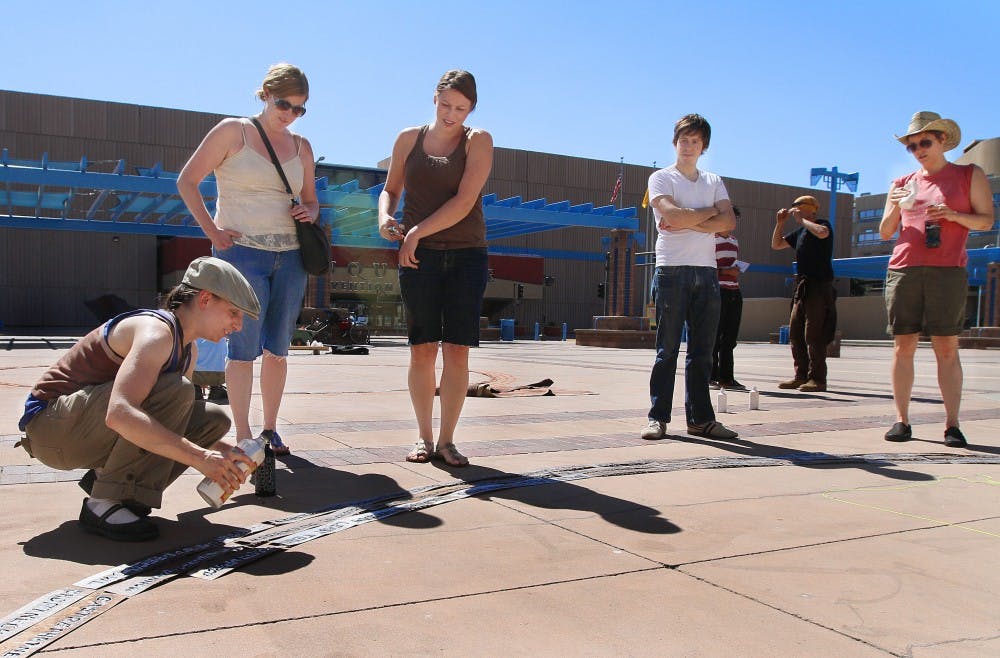It’s 100 degrees, possibly hotter, on the ground, but Daniel Richmond is on his knees pouring fine sand over searing hot metal stencils at the Downtown Civic Plaza.
Names like “Colorado Chipmunk,” “Peregrine Falcon” and — close to UNM’s heart — “Mexican Wolf” form when Richmond, a UNM MFA candidate, lifts the stencil off the ground.
All the names are the 112 endangered species in New Mexico, as defined by the Game and Fish Department.
The stencils and dirt form a circle about 20 feet in diameter. Richmond works in one of four so far formed. The lines of dirt stand in contrast to the cracked concrete.
He said the inspiration for the project originated from his childhood in Vermont.
“I spent my childhood playing in the trees, running through corn fields,” Richmond said. “I started to notice everything was alive.”
From there, his love of animals manifested itself in a variety of ways. Generally a sculptor, Richmond said he has done a lot of projects about the interconnectivity of life. Richmond did a similar project on Smith Plaza earlier this year.
Some of the stenciled names disappear as people walk through the dirt or when the wind starts to pick up. However, Richmond said the fleeting nature of the project is what makes it so substantial.
“It’s the names themselves,” Richmond said. “They can have validity and force in themselves. The names, though, disappear. That connection is really important. We’re all a passing thing.”
Back on the concrete, others diligently work on pouring sand over stencils.
Jane Gordon, with a few other volunteers, has been working since 7:30 a.m. By 10 a.m., 10 volunteers were stenciling.
Gordon said the names and the process behind them caught her attention.
Get content from The Daily Lobo delivered to your inbox
“It’s ephemeral,” she said. “You lift the stencils and they are going to get blown away. It’s a wonderful metaphor.”
Another volunteer, Alex Goldner, said the sizzling heat was a necessary part of the installation.
“It’s us paying for all these species,” he said, wiping sweat from his brow. “We are paying for trying to spread the word.”
Goldner, decked out in a wide-brimmed hat, a handkerchief around his neck and sunscreen glistening from his skin, continued to work. The stencils were hot to the touch, yet he held them steady while directing sand over them. He said the sand-sketched names help to put the plight of endangered species back in the minds of New Mexicans.
“It’s a gentle reminder,” he said. “It mimics how things go in and out of the public consciousness. Whether we think about it or not, things are happening in the world, and we are a big part of it.”
It would be easy to cite human destruction, like the Gulf of Mexico oil spill, as the reason behind the dangers these species face, but the cause is deeper than that, said Nathan Newcomer, associate director of New Mexico Wilderness Association.
He motions to the “Aplomado Falcon” stencil and tells the story of how he and his group helped secure its future. He said too few people are making actual efforts to help the environment.
“If you look at the conservation movement today, it’s a lot of old people,” Newcomer said. “Young people don’t do anything actively. It’s clichéd, but true. They are the future. They’ve got to be educated. They have to know what’s going on.”
Richmond said he was happy to see everyone involved in the project.
“Whatever gets done, gets done,” he said. “It’s the idea that we, as a community, are doing this thing.”






